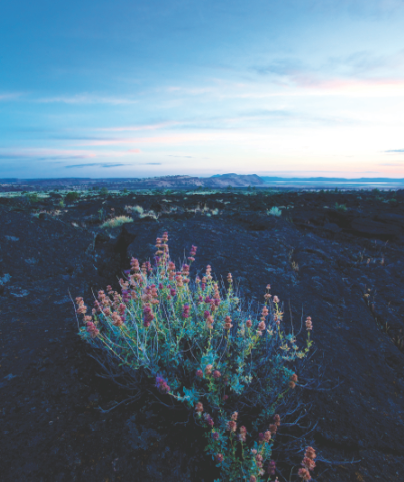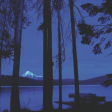

 Spring '24 Issue - Best Of Winners Announced & More
Spring '24 Issue - Best Of Winners Announced & More 
Wednesday, January 13, 2016
Lava Beds - The Way Home
History
Lava Beds
The Way Home
Story by Sandy Cathcart
Looking out over the Lava Beds National Monument just across the border from Southern Oregon into California, it’s hard to believe the turbulent history of this remote part of the world. More than lava flows have ripped this land apart; human hearts have been torn apart as well.
It all began as a place called home to the Modoc Tribe and the Ancients who enjoyed daily life here. They followed the seasons gathering food in Butte Valley and along the shores of Lost River, Clear Lake and 94,000-acre Tule Lake. They hunted and fished and used fibrous tule reeds for baskets, hats, arrow shafts and lightweight canoes. Their work was beautiful as well as exceptionally functional. The Ancients left a journal of their stories carved and painted in stone. The lake is smaller today, but the stories are still here for all to see. Visitors who stand beneath Petroglyph Point often remark about a “feeling” of peace and sacredness while viewing the carvings.
Known as the “people of the South Lake,” the Modoc were a unique and culturally detached band who lived their lives in relative obscurity until the arrival of white Europeans in the early Nineteenth century.
At first, the Modoc and fur traders were able to live well with one another. When the first settlers arrived, the Modoc often worked on nearby farms and ranches, trading for livestock and other necessities. They wore clothing patterned after the new settlers and took on names given them. It was during this time Modoc tribal member Keintpoos became known as Captain Jack.
Today, when you walk through Captain Jack’s stronghold, take time to remember the story of the Modoc people. It is a sad story of how the entire tribe was removed from their homeland to live among the Klamath, their traditional enemies. In less than a year, a number of Modoc, including Captain Jack and 371 other Modoc men, women and children, fled the reservation and headed back south, returning to the land of their forefathers. For two years, Captain Jack pleaded for a separate reservation along the Lost River. Today, looking over this vast, remote land, it is difficult to understand why the government did not grant his request. All the Modoc wanted was a place called home.
What ensued was probably the most remarkable and costliest Indian war ever fought in American history. For six months, less than sixty Modoc warriors held off an army that came to number over a thousand U.S. troops.
By war’s end, fatalities included 53 U.S. soldiers, 17 civilians, two Warm Springs Scouts, five Modoc women and children, and 15 Modoc warriors, only five of whom were killed in battle
On October 3, 1873, Captain Jack and three of his warriors were hanged on charges of war crimes. Nine days later, 42 men, 59 women and 54 children were loaded on wagons and taken first to Yreka, California and then to Redding where they were stuffed into railroad cars intended for hauling cattle and transported across 2,000 miles in the cold of winter.
They ended in Oklahoma with little more than a blanket and a will to survive. By 1891, there were only 68 Modoc still alive out of the 163 who were sent to the Quapaw Agency. It is a tribute to their courage and determination that despite General Sherman's efforts to wipe the Modoc from the face of the earth, they have survived. The story of the Modoc will always be one of pride, strength and an uncompromising desire to carry on.
In 1942, a different migration took place.
This time the U.S. was at war with Japan. The government uprooted over 110,000 people of Japanese ancestry from their homes and communities on the West Coast. Over half these people were U.S. citizens. Entire families had just days to prepare before being loaded into cars, busses and trains and taken to remote places. They were allowed to take only a few possessions with them; many lost their homes and jobs.
Nearly 19,000 men, women and children landed at Tule Lake Segregation Center, located on the same land Captain Jack called home. The center opened on May 25, 1942 and was the last of ten national centers to close on March 20, 1946.
Internees had no way of escaping the incessant summer winds or winter’s bitter cold as they worked the fields and huddled in barracks sided only with wood and tar paper. They stared off into the distance at snow-covered Mount Shasta wondering if they would ever see home again. The hastily built barracks were located at 4,000 feet on a flat and treeless terrain. Rooms contained eight single beds, leaving very little space for any kind of privacy; they contained no cooking facilities or indoor plumbing. Women gave birth here, children played and laughed. Many elders practiced “gaman,” a stoic perseverance in order to bear the unbearable. Remember Mr. Hikaru Sulu, the helmsman of the USS Enterprise on Star Trek? The actor who portrayed him, George Takei, lived here with his family as a young boy.
It’s hard to imagine the expanse of barracks extending into the distance when you stand on the grounds today, but listen carefully and you may hear the ancient cries of a people unjustly held mingling with the heart-breaking beat of a Native drum. Deer congregate here now, along with migrating birds and a lone coyote. This is big sky country where most destinations seem very far away. It is no wonder that one detainee wrote his plea on a wall, “Show me the way to go to home.”
Tread lightly as you visit and remember the price of hatred and prejudice. Restoration is spreading across the land; perhaps we can allow its healing wind to also work in our hearts.
Lava Beds National Monument
1 Indian Well, Tulelake, CA (just across the border from Klamath Falls and Merlin, Oregon)
530-667-8100
www.nps.gov/labe/index.htm
Tule Lake Unit of WWII Valor in the Pacific National Monument
Tulelake-Butte Valley Fairgrounds Museum
800 South Main St., Tulelake, CA
Staffed Memorial Day through Labor Day, 8:30 a.m. to 5 p.m.
530-667-5312
www.nps.gov/tule/index.htm
SIDEBAR
Lava Beds National Monument
Fees:
Seven-Day Entrance Fee is $15 per vehicle. There are several cheaper options available on the website.
Campground fees are $10 per vehicle per night.
Cave Exploration:
Over 700 known caves. The combined length of those that have been surveyed is more than 30 miles. Twenty developed caves are waiting to be explored by park visitors. Most are open year round. Check the website for gear and safety information.
Wildlife Viewing:
Home to 14 species of bats and a surprising array of wildlife and fauna. Stop at the East and West Wildlife Overlooks and plan a visit to nearby Tule Lake National Wildlife Refuge.
Historical Sites:
Petroglyph Point, Captain Jack’s Stronghold, Gillems Camp and Sheepy Ridge, Thomas-Wright Battlefield and Black Crater and more.
Hikes, walks, talks, tours and more:
You can explore on your own or join a ranger-led tour.
Special Events:
Timeline Living History event, Astronomy Day & Night Sky event and Jr. Ranger Day are a few of the scheduled events.
Events & Promotions
Apr
26
Apr
27
Apr
28
Central Point
Charlee Prayers & The Double Dares play Rellik
Charlee Prayers & The Double Dares play Rellik
Apr
29
May
03
Gold Hill
Del Rio Vineyard Dinner in the Vineyard Spring edition OREGON FEAST
Let's celebrate Oregon Wine Month. Join us for an evening of wine ...

















